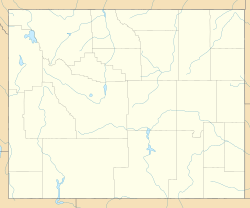Brigham Young Oil Well facts for kids
Quick facts for kids |
|
|
Brigham Young Oil Well
|
|
| Location | Northeastern quarter of the northeastern quarter of Section 4, Township 13, Range 119 |
|---|---|
| Nearest city | Evanston, Wyoming |
| Area | 0.5 acres (0.20 ha) |
| NRHP reference No. | 85000872 |
| Added to NRHP | April 25, 1985 |
The Brigham Young Oil Well is a special place near Evanston, Wyoming. It's an oil seep, which means natural oil comes up from the ground. This oil seep was found and used by the first Mormon group traveling to Utah. Their leader was Brigham Young.
The pioneers used the oil they found on the surface for many things. They put it on their wagon wheels to make them turn smoothly. They also used it to polish things and even as a poultice (a soft, moist cloth used for healing). After the group reached Great Salt Lake, some people went back. They dug a well at the oil seep so other pioneers could use it too. This well was helpful until 1869. That's when the Union Pacific Railroad started bringing oil to Salt Lake City.
History of the Oil Well
People think that trappers who built Fort Bridger knew about this oil well. But the first time it was written about was in 1848. A man named W. Clayton wrote a guidebook. He had traveled with the first Mormon group that settled the Salt Lake Valley in 1847.
There is a lot of oil in the area around the Brigham Young Oil Well. Another nearby oil spot is called the White Oil Well. It is on Hilliard Flat, in the same area. Judge C.M. White started working at the White Oil Well in 1867. He dug down about 480 feet (150 m) (146 meters). But he stopped working there in 1868. Later, an oil company from Evanston tried to get more oil from the same spot. But they also gave up soon after.
How the Oil Reaches the Surface
Scientists believe the oil at the Young Well comes up because of a fault underground. A fault is like a big crack in the Earth's crust. This fault is not as big as the Absaroka Fault, but it's large enough. It lets oil from deep oil shale layers rise to the surface.
The oil from both the Brigham Young Oil Well and the White Oil Well is a type called "heavy crude oil." In 1905, a study suggested that this heavy oil comes from the same source as lighter oil found in the Benton region. The study thought that the lighter parts of the Hilliard Flat oil evaporate before it reaches the surface. This study also noted that only a few gallons of oil seeped out each day at that time.
A Historic Site
In 1985, the Brigham Young Oil Well was added to the National Register of Historic Places. This means it's a very important historical site. It was listed because of how important it was to the pioneers who traveled through the area in 1847. It helped them on their long journey.



